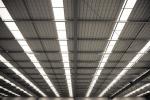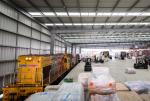Positively Mainstream
It’s less than a year since Mainstream added 3 Kiwi Street in Otahuhu to its national network. It was an advance in environmentally sustainable transportation infra-structure, a hub that integrates road and rail freight and provides an interchange between the two, as well as long-term on site storage.
Achieving this required
co-operation between Mainstream, which has always been focused on speed and consistency of service, Goodman New Zealand, which had a site for sale that was difficult to access, and KiwiRail, which was keen on growing rail users. When Ki-wiRail gave a green light allowing a new road to access the site across existing track, the deal was struck and planning begun.
The main interchange of freight occurs in an open warehouse (3700m2) that accommodates both truck loading and unloading, a new rail siding from the adjacent KiwiRail yard, and access to a larger, main warehouse (6428m2). Entry is off Kiwi Street via a railway crossing, with a second access point off Savill Drive. The office, on the north western side of the side, is the pivotal point between the clockwise flow of trucks and the site car-parking off to the west. To the east is a large container yard (2806m2) with a canopy allowing covered access to the warehouse. To the south is the exit route that includes a weigh station and allows drivers the option of turning left into Savill Drive or continuing back to Kiwi Street.
Tapered welded steel portals are used for the two warehouse structures. High capacity flooring is achieved by two-way post-tensioned slabs after piling. The large span roofs have been constructed without steps. This removes the overlap joint and the risk of corrosion.
The roof by Steel & Tube is ST963. The sheets are profiled with four specially designed ribs (46mm in height) Unique design enhancements stiffen the rib shape to provide resistance to both wind uplift and point load distortion. As some of the long roof sheets exceeded 40 metres in length special provisions had to be made to accommodate thermal movement. The white roofing has the highest possible solar reflectance externally to reduce heat gain in the warehouse space. COLORSTEEL® cladding was painted on both sides – exterior in the company’s signature ‘Mainstream Green’ - interior with a lighter paint to enhance internal reflectivity and Clear Glass Reinforced Polyester (GRP) sheets matching the ST963 profile, were added to each bay provide a high level of natural light thus reducing energy costs.
The Office is clearly differentiated from the warehouses to make for easy orientation of drivers as they arrive. It uses glass and charcoal coloured precast panels that have cast-in shelves to provide solar shading to the north. White painted undersides act as light shelves, which deflect indirect light into the office space.
The entrance is emphasised with full-height glass and a projecting portico. Inside wide shelves over the north-facing windows reduce the heat gain during summer months. All circulation and meeting rooms are located towards the western end of the building, and this creates an open plan area that is flexible for future planning. The eastern façade of the office is shielded from a lowered eastern sun by the warehouse, while a natural light well exists between the warehouse and the office. The double-height void separating the upper floor office reduces heat transfer. Heat can also be thermostatically controlled by an extract to the atrium; automated blinds can be unfurled to cover all glazed areas. Meanwhile, the ground floor has been tiled to allow the thermal capture of solar radiation, while in the open plan office, spandrels to desk height ensure that there is 30% less heat gain than full height glazing.
Jonathan Walker, of JWA Architects Ltd, was appointed as architect for this project, which he’s pleased sets a good standard of design for its location. “It’s a strongly industrial area,” he says, “and I believe that we’ve set an improved level of quality for an industrial building in this domain. The Mainstream building and its site create a strong sense of identity that helps improve this neighbourhood. The sustainability features incorporated in the modern urban design principles that we applied make a significant contribution, which includes reducing the carbon footprint.
The project has taken considerable planning and many detailed discussions about maximising both transportation efficiency and storage capacity. It was at a time when the Christchurch rebuild urgently needed logistical support. We addressed that and Mainstream’s general expansion needs by integrating a rail head with a road transport depot in the same building. There aren’t many of those in New Zealand. And if there were to be spikes in the oil price, Mainstream has positioned itself to be able to mitigate rising diesel costs. In fact, it should come as no surprise that Mainstream is already seriously considering an extension, which it can make organically on the same site, without a major dislocating move.”
This has been confirmed by Mainstream’s National Supply Chain Manager, Neil Bell: “I’m happy to say that the next phase of expansion is currently being planned.”
Client Mainstream Warehouse
Archtitects:
JWA Architects Ltd. Auckland
Telephone: 09 368 1111
Builders: Federal Builders Ltd.
Roofers: Kiwi Roofing
Roofing Supplied by Steel&Tube
Telephone: 09 2733056
Roofing: ST963 COLORSTEEL® Endura Cloud
Cladding: ST963 COLORSTEEL® Mainstream Green





